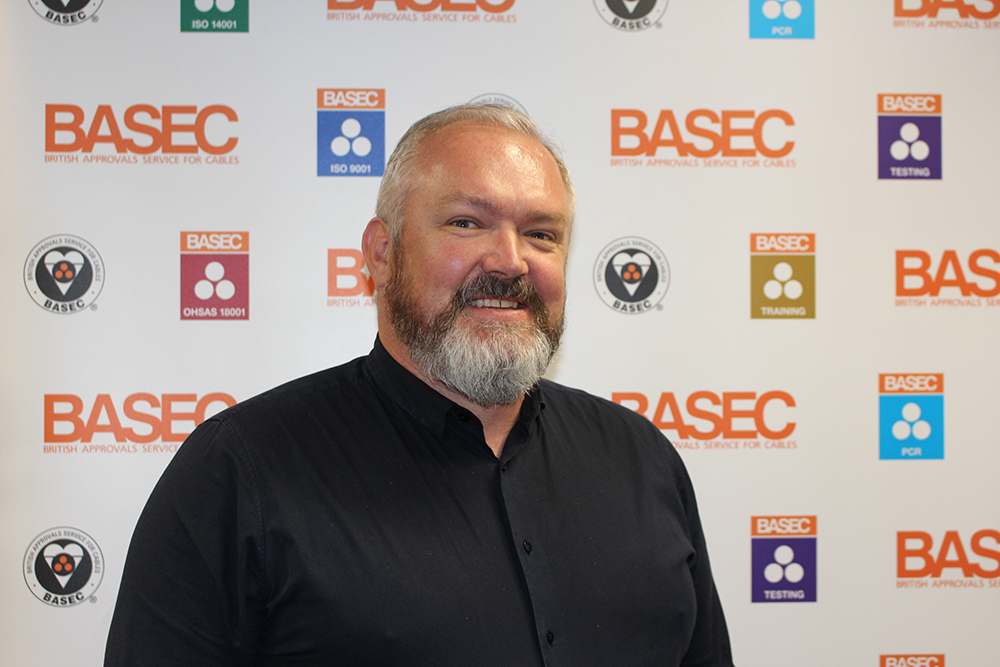As industries increasingly digitalize, the need for reliable data cables is critical. Mark Froggatt, Technical Director at BASEC, outlines the importance of obtaining third party certification when it comes to data communication cables and discusses how the role of cable testing helps ensure only high-quality cable is used within the communications market.

In a world reliant so heavily on data, poor quality and non-compliant data cables can have a catastrophic impact on the end-user. It is crucial that structured cabling systems can accommodate data demand both now and in the future.
Data cables – when quality matters
It is becoming increasingly visible that the world is ever more reliant on digital technology. In fact, the world is in the midst of what is referred to as a ‘Digital Transformation’.
An IDC report revealed that today more than 5 billion consumers interact with data every day and by 2025 this will increase to 6 billion – 75% of the world population. In 2025, each connected person will have at least one data transaction every 18 seconds. Many of these transactions are because of the billions of IoT devices connected across the globe which are expected to create over 90zB of data in 2025.
There is great emphasis on reliable data transmission, both in respect to volume and also transfer rates. In short, consumers are demanding high levels of data and more than ever this data is required in real time. Whether in business or leisure, there is a forever increasing number of data transactions, both with human interface and with the increasing scope of the Internet of Things. Furthermore, with the expansion of the Industrial Internet of Things, these transactions will inevitably increase further.
Indicators of performance quality
Data network infrastructure quality should be carefully considered to assess whether or not it will be able to operate efficiently, both now and as technologies advance in the future. Data networks have been evolving since 1985. This is when the first voice grade copper cabling was used to transmit data, by means of a simple unshielded twisted pair cable, which managed to transfer data at a rate of 1Mbps.
Of course, in 2020, the transmission requirements have significantly evolved and now copper structured cabling specifications have progressed further. Increases in data demand has meant a far greater emphasis on cable design to reduce or eliminate the undesirable effects of electromagnetic interference (EMI). Pair geometry, choice of dielectric and shielding are all design considerations when manufacturers are looking to negate the impact.
The progression of established standards IEC, ANSI/TIA and EN, which specify the requirements of structured cabling systems has imposed higher requirements, in respect to the measurement of data integrity and immunity to EMI. Test parameters have become more onerous. The key performance indicators for a data cable are attenuation and crosstalk, therefore in-depth tests have been developed to measure both. The tests determine the interference experienced, which in turn impacts the ability of the cable to transmit data without errors.
To enable verification of cable, it is advisable to ensure that structured cabling is purchased from a manufacturer who is certified by a third-party approval company. Approved cable benefits the end-user and installer alike, in that the likelihood of infrastructure failure down the line is significantly reduced.
Approved cable products are assessed to ensure that they are produced using only high-quality components and process, or factory controls are also audited as part of any certification to ensure standard’s compliance is maintained.
During the certification process cables are measured against various performance parameters, which reflect those the cable will experience during operation, considering environmental challenges it may encounter during installation and its life span. For example, thermal ageing and chemical resistance exposure are targeted tests used to qualify performance.
These tests act to give both the installer and end-user piece of mind that the cable being used can accommodate high demands for data, while withstanding external influencers which would otherwise compromise performance and, potentially, the integrity of data for end-users.
The adoption of data cables in almost all industries has meant that transmission testing alone may not indicate the cables overall performance. For this reason, ANSI/TIA standards have developed a mechanical, ingress, chemical and electromagnetic (MICE) classification to determine the harshness of the cable’s surroundings.
Helping you safeguard networks
Any manufacturer going through the approval process is assessed on the basis of many contributing factors, including its quality management systems, how they validate design, how they purchase materials, how they deal with non-conforming product, down to how they train their teams, all of which contributes to the functioning of an effective cable manufacturing business.
Additionally, there is a comprehensive audit where the key processes involved directly in the manufacture of structured cabling are assessed. Each method or system is reviewed in depth to ensure repeatability and high-quality output. In doing so this minimizes the risk of product failures throughout every stage of the manufacturing process.
Samples from each cable design are forensically examined to ensure that all relevant specification parameters are satisfied. The outcome of all of the above is to install confidence for both the manufacturer, installer and end-user that the structured cabling system is suitable for its intended purpose.
Cables form the building blocks of any IT infrastructure therefore high-quality product, proven to meet the required output performance levels is critical. Using a certified manufacturer takes the way any guesswork and enables you to be sure of product quality.
It is critically important to ensure that the structured cabling installed within your infrastructure is tested and verified to meet all of the complex data transmission parameters, often demanded by today’s telecommunications industry. In today’s data driven world any instance of system outages, data corruption or simple loss of time can cause businesses across the world a myriad of issues and problems.
To conclude, data communication testing and certification helps you to ensure the level of quality, in line with the industry standards, or above this minimum can be successfully delivered to your end-user. One, which a non-approved cable cannot guarantee. The responsibility for maintained levels of quality falls on every touch point of the supply chain, this starts right at the beginning of the telecommunications data network specification process, where independently approved cable should be outlined as a requirement.
As the purchase power moves from this decision, project owners and procurement teams should also check for verified certification. Finally, care should also be taken at both the installation and once functioning in operation, so as to ensure unnecessary damage to the cable is not encountered.
Third party certification offers continuous peace of mind, delivered through a rigorous auditing and product sampling schedule to ensure cables consistently meet the required standards. Data cable certification is essential to making sure structured cabling systems are reliable and efficient accommodating the forever increasing data demand.
For more information visit the BASEC website.



